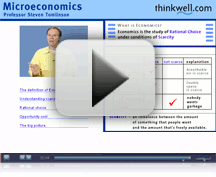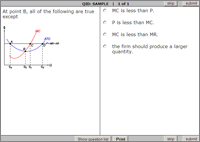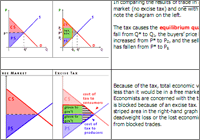Economics
Thinkwell's Economics is a combination of our Microeconomics and Macroeconomics courses; nothing is left out, so it's a fantastic 2-for-1 deal. Watch a sample video and you'll see that Steven Tomlinson is one of our very best professors, and that his ability to make economics clear and relevant will make sure you're ready for tomorrow's Econ class at school. It's an amazing study aid, and because it's available night or day for one fixed price, it's better than a tutor.
Most colleges offer microeconomics and macroeconomics as one-semester courses. Some colleges present economics as a survey course covering microeconomics and macroeconomics topics but lasting only one semester. At least one semester in economics is recommended for a college-prep curriculum.
Our complete Economics package includes:- 12-month Online Subscription to our complete Economics course with video lessons, automatically graded problems, and much more.
- Printed Notes (optional) are the Economics course notes from the Online Subscription printed in a black & white, on-the-go format. These are available for purchase from the Economics Course Site.
- CD Set (optional) contains all of the video lessons so that you can watch them when you're away from the internet.
Printed Notes and CD Sets require the purchase of an online subscription.
Money-Back Guarantee
Economics Materials
Online Subscription, 12-month access
Access to a complete online package that includes everything you need.
- Thinkwell's video lectures cover the comprehensive scope and sequence of topics covered in both a macro- and microeconomics course.
- Our automatically graded exercises with immediate feedback allow you to quickly determine which areas you'll need to spend extra time studying.
- Concise, illustrated review notes help you distill the fundamental ideas, concepts, and formulas you'll need to know in order to succeed.
- Chapter practice tests ensure that you're up to speed, prepped, and ready to go (only in homeschool version).
- Subscriptions start when you are ready. Buy now and activate your course anytime you like. Wait up to one year to activate your subscription; your 12-month subscription doesn't begin until you say so!
CD Set Video Lectures on CD-ROM
This optional CD-ROM set delivers the exact same video lectures delivered online, but without an internet connection. Online Subscription is required; CDs not sold separately. The CDs only contain the videos.
Economics Details
Thinkwell's Economics includes:
- More than 180 educational video lessons (see sample)
- 1000+ interactive macroeconomics exercises with immediate feedback allow you to track your progress (see sample)
- Printable illustrated notes for each topic
- Glossary of more than 200 macroeconomics terms
- Engaging content to help students advance their knowledge of economics:
- Supply and demand
- Measuring output, income, GDP, and cost of living
- Unemployment and inflation
- Aggregate expenditures
- Banking, spending, saving, and investing money
- Monetary and fiscal policy
- Productivity and growth
- International macroeconomics
Table of Contents
(Expand All - Close All)1. Introduction to Economic Thinking
- 1.1 The Basics of Economics
- 1.1.1 Defining Economics
- 1.1.2 What Economists Do
- 1.1.3 Macroeconomics and Microeconomics
- 1.1.4 An Overview of Economic Systems
- 1.1.5 Case Study: The Work of Adam Smith
- 1.2 Graphs in Economics
- 1.2.1 Using Graphs to Understand Direct Relationships
- 1.2.2 Plotting a Linear Relationship between Two Variables
- 1.2.3 Changing the Intercept of a Linear Function
- 1.2.4 Understanding the Slope of a Linear Function
- 1.3 Advanced Graphical Concepts
- 1.3.1 Understanding Tangent Lines
- 1.3.2 Working with Three Variables on a Graph
- 1.4 Production Possibilities
- 1.4.1 Understanding the Concept of Production Possibilities Frontiers
- 1.4.2 Understanding How a Change in Technology or Resources Affects the PPF
- 1.4.3 Deriving an Algebraic Equation for the Production Possibilities Frontier
- 1.5 Comparative Advantage
- 1.5.1 Defining Comparative Advantage with the Production Possibilities Frontier
- 1.5.2 Understanding Why Specialization Increases Total Output
- 1.5.3 Analyzing International Trade Using Comparative Advantage
- 1.5.4 Outsourcing
2. Understanding Markets
- 2.1 Demand
- 2.1.1 Understanding the Determinants of Demand
- 2.1.2 Understanding the Basics of a Demand Curve
- 2.1.3 Analyzing Shifts in the Demand Curve
- 2.1.4 Changing Other Demand Variables
- 2.1.5 Deriving a Market Demand Curve
- 2.2 Supply
- 2.2.1 Understanding the Determinants of Supply
- 2.2.2 Deriving a Supply Curve
- 2.2.3 Understanding a Change in Supply versus a Change in Quantity Supplied
- 2.2.4 Analyzing Changes in Other Supply Variables
- 2.2.5 Deriving a Market Supply Curve from Individual Supply Curves
- 2.3 Equilibrium
- 2.3.1 Determining a Competitive Equilibrium
- 2.3.2 Defining Comparative Statics
- 2.3.3 Classifying Comparative Statics
- 2.4 Elasticity
- 2.4.1 Defining Elasticity
- 2.4.2 Calculating Elasticity
- 2.4.3 Applying the Concept of Elasticity
- 2.4.4 Identifying the Determinants of Elasticity
- 2.4.5 Understanding the Relationship between Total Revenue and Elasticity
- 2.5 Interfering with Markets
- 2.5.1 Understanding How Price Controls Damage Markets
- 2.5.2 Understanding the Problem of Minimum Wages in Labor Markets
- 2.5.3 Understanding How an Excise Tax Affects Equilibrium
- 2.6 Agriculture Economics
- 2.6.1 Examining Problems in Agricultural Economics
3. Consumer Choice and Household Behavior
- 3.1 Utility Theory
- 3.1.1 Understanding Utility Theory
- 3.1.2 Finding Consumer Equilibrium
- 3.2 Budget Constraints and Indifference Curves
- 3.2.1 Constructing a Consumer's Budget Constraint
- 3.2.2 Understanding a Change in the Budget Constraint
- 3.2.3 Understanding Indifference Curves
- 3.3 Consumer Optimization
- 3.3.1 Locating the Consumer's Optimal Combination of Goods
- 3.3.2 Understanding the Effects of a Price Change on Consumer Choice
- 3.3.3 Deriving the Demand Curve
4. Production and Costs
- 4.1 The Basics of Production
- 4.1.1 Understanding Output, Inputs, and the Short Run
- 4.1.2 Explaining the Total Product Curve
- 4.1.3 Drawing Marginal Product Curves
- 4.1.4 Understanding Average Product
- 4.1.5 Relating Costs to Productivity
- 4.2 Variable Costs
- 4.2.1 Defining Variable Costs
- 4.2.2 Graphing Variable Costs
- 4.2.3 Graphing Variable Costs Using a Geometric Trick
- 4.3 Marginal Costs
- 4.3.1 Defining Marginal Costs
- 4.3.2 Deriving the Marginal Cost Curve
- 4.3.3 Understanding the Mathematical Relationship between Marginal Cost and Marginal Product
- 4.4 Average Costs
- 4.4.1 Defining Average Variable Costs
- 4.4.2 Understanding the Relationship between Average Variable Cost and Average Product of Labor
- 4.4.3 Understanding the Relationship between Marginal Cost and Average Variable Cost
- 4.5 Total Costs
- 4.5.1 Defining and Graphing Average Fixed Cost and Average Total Cost
- 4.5.2 Calculating Average Total Cost
- 4.5.3 Putting the Cost Curves Together
- 4.6 Long-Run Production and Costs
- 4.6.1 Defining the Long Run
- 4.6.2 Determining a Firm's Returns to Scale
- 4.6.3 Understanding Short-Run and Long-Run Average Cost Curves
- 4.6.4 Shifts in Cost Curves
- 4.7 Isocost/Isoquant Analysis
- 4.7.1 Constructing Isocost Lines
- 4.7.2 Understanding Isoquants
- 4.7.3 Finding the Cost-Minimizing Combination of Capital and Labor
5. Perfect Competition
- 5.1 The Basic Assumptions of Competitive Markets
- 5.1.1 Calculating Total Revenue
- 5.1.2 Understanding the Role of Price
- 5.1.3 Understanding Market Structures
- 5.1.4 Finding Economic and Accounting Profit
- 5.2 Calculating Profit and Loss
- 5.2.1 Finding the Firm's Profit-Maximizing Output Level
- 5.2.2 Proving the Profit-Maximizing Rule
- 5.2.3 Calculating Profit
- 5.2.4 Calculating Loss
- 5.2.5 Finding the Firm's Shut-Down Point
- 5.3 Market Supply
- 5.3.1 Deriving the Short-Run Market Supply Curve
- 5.3.2 Relating the Individual Firm to the Market
- 5.3.3 Examining Shifts in the Short-Run Market Supply Curve
- 5.3.4 Deriving the Long-Run Market Supply Curve
- 5.4 Competitive Firms' Responses to Price Changes
- 5.4.1 Examining the Firm's Long-Run and Short-Run Adjustments to a Price Increase
6. Other Market Models
- 6.1 Monopolies
- 6.1.1 Defining Monopoly Power
- 6.1.2 Defining Marginal Revenue for a Firm with Market Power
- 6.1.3 Determining the Monopolist's Profit-Maximizing Output and Price
- 6.1.4 Calculating a Monopolist's Profit and Loss
- 6.1.5 Graphing the Relationship between Marginal Revenue and Elasticity
- 6.2 The Social Cost of Monopoly
- 6.2.1 Determining the Social Cost of Monopoly
- 6.2.2 Calculating Deadweight Loss
- 6.2.3 Understanding Monopoly Regulation
- 6.3 Oligopoly
- 6.3.1 Introducing Oligopoly and the Prisoner's Dilemma
- 6.3.2 Understanding a Cartel As a Prisoner's Dilemma
- 6.3.3 Understanding the Kinked-Demand Curve Model
- 6.4 Monopolistic Competition
- 6.4.1 Defining Monopolistic Competition
- 6.4.2 Understanding Pricing and Output under Monopolistic Competition
- 6.4.3 Understanding Monopolistic Competition As a Prisoner's Dilemma
7. Resource Markets
- 7.1 The Derived Demand for Labor
- 7.1.1 Deriving the Factor Demand Curve
- 7.1.2 Deriving the Least-Cost Rule
- 7.1.3 Analyzing the Labor Market
- 7.2 Monopsony
- 7.2.1 Understanding Labor Market Power and Marginal Factor Cost
- 7.3 Capital Markets
- 7.3.1 Analyzing Capital Markets
8. Market Failures
- 8.1 Overview of Market Failures
- 8.1.1 Understanding Market Failures
- 8.2 Public Goods and Public Choice
- 8.2.1 Defining Public Goods
- 8.2.2 Analyzing the Tax System
- 8.2.3 Understanding Public Choice
- 8.3 Uncertainty
- 8.3.1 Understanding Expected Value, Risk, and Uncertainty
- 8.3.2 Understanding Asymmetric Information as an Economic Problem
- 8.3.3 Understanding Moral Hazards in Markets
- 8.4 Externalities
- 8.4.1 Defining Externalities
- 8.4.2 Explaining How to Internalize External Costs
- 8.4.3 Explaining How to Internalize External Benefits
- 8.5 Solutions to Externalities
- 8.5.1 Finding a Market Solution to External Costs
- 8.5.2 Finding a Negotiated Settlement to an External Cost
- 8.5.3 Applying the Coase Theorem
9. Evaluating Market Outcomes
- 9.1 Normative Economics
- 9.1.1 Measuring the Benefits of Consumption
- 9.1.2 Using the Demand Curve As a Measure of Benefit
- 9.2 Calculating Total Economic Value
- 9.2.1 Quantifying Social Benefit
- 9.2.2 Quantifying Social Cost
- 9.2.3 Determining Total Social Cost
- 9.2.4 Understanding Economic Value
- 9.3 Consumer and Producer Surplus
- 9.3.1 Understanding Producer and Consumer Surpluses
- 9.3.2 Calculating Total Economic Value
- 9.4 Market Interference and Economic Value
- 9.4.1 Understanding the Effects of Price Controls
- 9.4.2 Understanding How Price Controls Destroy Economic Value
- 9.4.3 Evaluating the Effects of an Excise Tax
- 9.4.4 Assessing the Effect of an Excise Tax on Economic Value
- 9.4.5 Understanding How a Tax Can Create Deadweight Loss
- 9.5 International Trade and Economic Value
- 9.5.1 Evaluating the Gains from International Trade
- 9.5.2 Understanding the Effects of Tariffs on Consumer and Producer Surpluses
10. Macroeconomic Measurements
- 10.1 Aggregate Output and Income
- 10.1.1 The Production Possibilities Frontier: Macroeconomic Applications
- 10.1.2 The Circular Flow Model
- 10.1.3 Real GDP
- 10.1.4 The BEA Procedure for Calculating Real GDP
- 10.1.5 Limitations of GDP and Alternative Indexes
- 10.1.6 The Growth of China as a Superpower
- 10.2 Approaches to Calculating GDP
- 10.2.1 The Expenditures Approach
- 10.2.2 The Income Approach
- 10.3 Cost of Living
- 10.3.1 Changes in the Cost of Living and the CPI
- 10.3.2 Calculating the Rate of Inflation
- 10.3.3 Comparing the CPI and the GDP Deflator
- 10.3.4 Hot Topic: Income Distribution in the United States
11. Economic Fluctuations: Unemployment and Inflation
- 11.1 The Business Cycle
- 11.1.1 Recessions, Depressions, and Booms
- 11.1.2 Theoretical Explanations for Cycles
- 11.2 Measuring Unemployment
- 11.2.1 Measuring the Labor Force and Unemployment
- 11.2.2 Types of Unemployment
- 11.3 The Natural Rate of Unemployment
- 11.3.1 Understanding the Natural Rate of Unemployment
- 11.4 Causes of Unemployment
- 11.4.1 Minimum Wage Laws
- 11.4.2 An Analysis of Labor Unions and Unemployment
- 11.4.3 Case Study: "La Causa": The United Farm Workers
- 11.4.4 The Theory of Efficiency Wages
- 11.4.5 Unemployment Insurance
- 11.5 Inflation
- 11.5.1 Inflation, Deflation, Stagflation, and Hyperinflation
- 11.5.2 Inflation and Purchasing Power
- 11.5.3 Short-Run Causes: Demand-Pull and Cost-Push Inflation
- 11.5.4 The Quantity Theory of Money
- 11.5.5 The Costs of Inflation
- 11.5.6 Case Study: Behavior during Hyperinflation
12. The Aggregate Expenditures Model
- 12.1 Historical Background
- 12.1.1 Say's Law and Keynes: An Overview
- 12.2 Components of Aggregate Expenditures
- 12.2.1 The Aggregate Expenditures Identity
- 12.2.2 Average and Marginal Propensities to Consume and Save
- 12.2.3 The Aggregate Expenditures Model
- 12.2.4 Case Study: The Paradox of Thrift
- 12.2.5 Autonomous Investment
- 12.3 Equilibrium GDP
- 12.3.1 The Expenditures Approach and the Savings Approach
- 12.4 The Multipliers
- 12.4.1 Applications of the Multipliers
- 12.5 Comparative Statics: The AE Model
- 12.5.1 Changes in Aggregate Expenditures
- 12.5.2 Changes in Taxes
- 12.5.3 Changes in Net Exports
- 12.5.4 Hot Topic: Does Social Security Need to Be "Saved"?
13. Money: Banking, Spending, Saving, and Investing
- 13.1 Money in the Economy
- 13.1.1 The Money Supply
- 13.1.2 Determinants of Money Demand
- 13.1.3 The Money Market
- 13.2 Financial Markets
- 13.2.1 Financial Markets and Intermediaries
- 13.2.2 Stocks and Bonds
- 13.2.3 The Price of Bonds and the Interest Rate
- 13.3 The Fed
- 13.3.1 The Federal Reserve System
- 13.3.2 Hot Topic: Are Reserve Requirements Necessary?
- 13.3.3 The Fed's Tools of Monetary Policy
- 13.3.4 Case Study: The Greenspan Era
- 13.4 The Creation of Money
- 13.4.1 How Goldsmiths Created Money
- 13.4.2 Case Study: Cigarettes As Money
- 13.4.3 How Banks Create Money
- 13.4.4 How the Fed Changes the Money Supply
- 13.5 Saving and Investment
- 13.5.1 Investment Demand
- 13.5.2 The Market for Loanable Funds and Crowding Out
- 13.5.3 Equilibrium in the Money Market
14. Aggregate Demand/Aggregate Supply Model
- 14.1 Aggregate Demand
- 14.1.1 Deriving the Aggregate Demand Curve
- 14.1.2 Movement along the Aggregate Demand Curve
- 14.1.3 Shifts in Aggregate Demand
- 14.2 Aggregate Supply
- 14.2.1 The Short-Run Aggregate Supply Curve
- 14.2.2 The Labor Market
- 14.2.3 The Long-Run Aggregate Supply Curve
- 14.3 Differences in the Long Run and the Short Run
- 14.3.1 The Classical View
- 14.3.2 Equilibrium in the Short Run
- 14.3.3 Equilibrium in the Long Run
- 14.3.4 Expectations in the Long Run and the Short Run
- 14.3.5 Long-Run Macroeconomic Equilibrium
- 14.3.6 Case Study: The U.S. National Debt
- 14.3.7 Hot Topic: Oil Shocks
- 14.4 The Phillips Curve
- 14.4.1 Definitions and the Historical Record
- 14.4.2 Expectations and the Phillips Curve
15. Monetary and Fiscal Policy
- 15.1 Recessions and Booms
- 15.1.1 Unanticipated Changes in Aggregate Demand
- 15.1.2 Unanticipated Changes in Aggregate Supply
- 15.2 Fiscal Policy: The Mainstream
- 15.2.1 Fiscal Policy Using the AD/AS Model
- 15.2.2 The Market for Loanable Funds and Government Policy
- 15.2.3 Timing Problems and the AD/AS Model
- 15.2.4 Automatic Stabilizers
- 15.2.5 Hot Topic: The Political Business Cycle
- 15.3 Fiscal Policy: Alternative Approaches
- 15.3.1 New Keynesian and New Classical Approaches to Fiscal Policy
- 15.3.2 Supply-Side Policy
- 15.4 Monetary Policy: The Mainstream
- 15.4.1 The Quantity Theory of Money (review)
- 15.4.2 Monetary Policy Using the AD/AS Model
- 15.4.3 Monetary Responses to Changes in the Economy
- 15.4.4 Monetary Policy: Accommodation
- 15.4.5 Hot Topic: Should Monetary Policy Be Made by Rule or Discretion?
- 15.5 Monetary Policy: Alternative Approaches
- 15.5.1 New Keynesians versus Monetarists
- 15.5.2 New Classical Macroeconomics
- 15.5.3 Case Study: Policy in the Great Depression
16. Productivity and Growth
- 16.1 The Elements of Productivity and Growth
- 16.1.1 The Rule of 70, Compounding, and Growth
- 16.1.2 The PPF, the AD/AS Model, and Long-Run Growth
- 16.1.3 The Production Function and Growth
- 16.1.4 The Definition of Productivity and Factors Affecting It
- 16.2 Policy and Growth
- 16.2.1 Investment
- 16.2.2 Other Policies to Encourage Growth
- 16.2.3 Hot Topic: Women's Roles in Rural Economic Growth
- 16.3 Emerging Economies
- 16.3.1 Growth in Emerging Economies
- 16.3.2 Policies to Promote Growth
- 16.3.3 Hot Topic: The Myth of Exploding Populations
17. International Focus
- 17.1 Microeconomics Background
- 17.1.1 Determining the Difference between a Closed Economy and an Open Economy
- 17.1.2 Understanding Exports in an Open Economy
- 17.1.3 Analyzing a Change in Equilibrium in an Open Economy
- 17.1.4 Analyzing International Trade Using Comparative Advantage
- 17.2 Exports, Imports, and Accounting
- 17.2.1 The International Flow of Goods and Services
- 17.2.2 Balance of Payments
- 17.2.3 Balance of Payments: An Example
- 17.2.4 Trade Balances
- 17.3 Exchange Rates
- 17.3.1 Nominal Exchange Rates
- 17.3.2 Real Exchange Rates
- 17.3.3 Purchasing Power Parity
- 17.3.4 Determination of Exchange Rates
- 17.3.5 Floating and Fixed Systems
- 17.3.6 The Managed Float
- 17.4 Government Policies
- 17.4.1 Government Budget Deficits and Trade
- 17.4.2 Trade Policy
- 17.4.3 Hot Topic: Winners and Losers in NAFTA
- 17.4.4 Political Instability and Trade
- 17.4.5 Hot Topic: Is the World Trade Organization a Conspiracy?
- 17.5 Transition Economies
- 17.5.1 Centrally Planned Economies
- 17.5.2 Policies to Change to Market Systems
- 17.5.3 Comparative Economic Performance
About the Author

Sample Video Lessons

Sample Interactive Exercises


